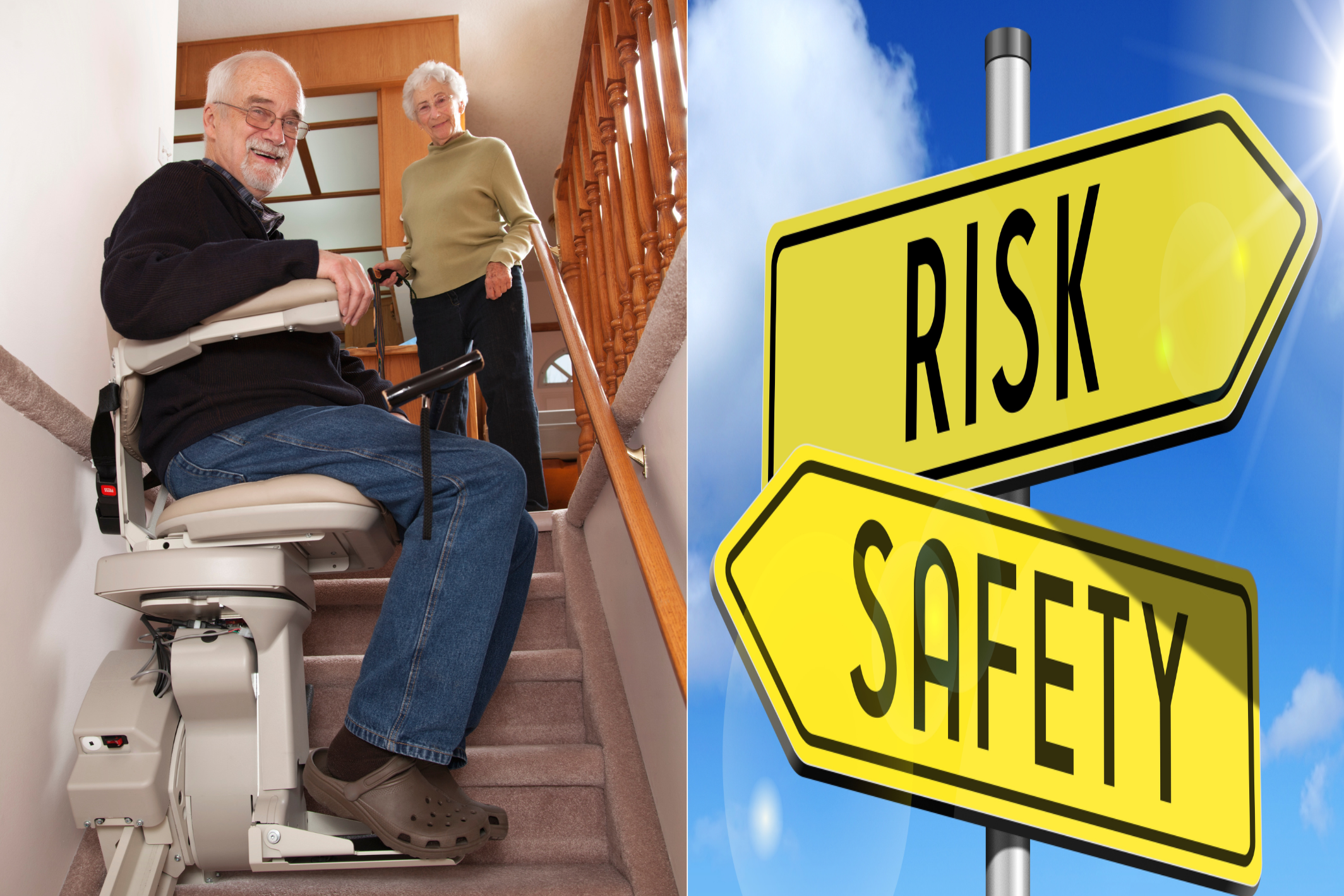Stairlifts have become a real lifesaver for many, making it easy and safe to move up and down the stairs.
Thanks to the latest technology, modern stairlifts now come with some pretty impressive safety features that ensure you can use them with total confidence.
In this blog, we’ll take a closer look at these important safety features, how they work, and why they’re key to keeping you safe every time you take a ride.
Why Stairlift Safety Matters
When it comes to stairlifts, safety is absolutely crucial. The people who rely on these devices are often elderly or disabled people, so these elevators must provide a reliable and secure way to navigate stairs. Don’t you think so?
The Need for Stairlift Safety
- Risk of Falls: Stairs can be one of the most dangerous spots in your home. A fall down the stairs could lead to serious injuries, so your stairlift must be designed to be as safe as possible.
- User confidence: If your stairlift doesn’t feel secure, you might hesitate to use it. And if you don’t use it, the stairlift isn’t doing its job. Ensuring that your device feels safe boosts your confidence and helps you use it properly.
- Peace of Mind: Knowing that your lift is safe helps your family and caregivers relax. They can rest assured that you’re using equipment that’s reliable and secure, which brings comfort and reassurance to everyone involved.
Modern stairlifts are built with these needs in mind. They come equipped with multiple safety features that are specifically designed to reduce risks and help you feel confident and secure when using your elevator.
Top safety features in modern stairlifts
Let’s take a closer look at the most important safety features you’ll find in today’s stairlifts. These features are designed to address specific risks and ensure the stairlift is as comfortable as possible for you or your loved one.
1. Seatbelt
Every modern lift for stairs includes a seatbelt. This simple yet effective safety feature makes sure you remain securely seated during the ride.
Why it’s important:
- Prevents falls: The seatbelt keeps you in place, especially throughout the ride.
- Provides reassurance: Even if the ride is smooth, a seatbelt adds an extra layer of security.
2. Swivel Seat
A swivel seat is an important safety feature. When the lift reaches the top or bottom of your stairs, the seat can swivel to face away from the staircase, allowing you to dismount safely.
Benefits:
- Reduces the risk of falls: You can exit onto a flat surface rather than stepping off onto the stairs.
- Easier transfer: For those with limited mobility, it’s easier to get on and off the stairlift when the seat is in the right position.
3. Safety Sensors
Advanced stairlifts are equipped with multiple sensors that detect obstacles on the stairs. If something is in the way, the elevator will automatically stop, preventing accidents.
Types of Sensors
- Footrest sensors: Find anything on the steps that could get in the way of the footrest.
- Carriage sensors: These sensors identify any obstructions in the stairlift’s railing or route.
- Seat sensors: Make sure you are seated correctly before the stairlift starts to move.
Safety sensors play an important role in reducing accidents caused by obstacles on stairs.
4. Battery Backup
Power outages can be a concern for stairlift users. However, today’s stairlifts are equipped with battery backup systems that allow your device to continue operating even when the power is out.
Why it matters:
- Uninterrupted use: You can still get up or down the stairs during a power cut.
- Safety during power outages: stops you from being stuck on the steps.
5. Call/Send controls
Call/send controls allow you or your caregiver to transfer the stairlift to the appropriate place (top or bottom of the stairs) without having to sit in the seat. Such a feature is very handy in households where multiple people might want to use the stairlift.
Advantages:
- Convenience: The stairlift can be called or sent to another floor without needing physical help.
- Shared use: Multiple users can benefit from the machine without any inconvenience.
6. Key Lock System
Some staircase lifts have a key lock system that restricts illegal use. This feature is particularly helpful in families with small children or when the stairlift is located in a public or semi-public space.
Why it’s beneficial:
- Prevents accidental use: Stops children or unauthorized individuals from operating the stairlift.
- Enhances security: Offers peace of mind that the stairlift will only be used by those who need it.
Top Safety Highlights
| Feature | What It Does | How It Helps You |
| Seatbelt | Keeps you securely seated | It prevents falls and gives you extra reassurance. |
| Swivel Seat | Rotates the seat to face away from the stairs. | Reduces the likelihood of falling when getting on or off. |
| Safety Sensors | Detects obstacles on the stairs | Stops the stairlift if something is in the way. |
| Battery Backup | Keeps the elevator running during a power outage | Let’s use the lift even if the power goes out. |
| Call/Send Controls | Moves the stairlift to the top or bottom without you needing to be in the seat | Adds convenience for you and others using the stairlift. |
| Key Lock System | Prevents unauthorized use of the stairlift | Keeps the stairlift secure from children or others. |
How Today’s Tech Keeps Your Stairlifts Safe
Technology plays a significant role in making stairlifts safer.
Let’s see how technological advancements are improving the safety features we’ve discussed.
Advanced Sensors and AI
With the incorporation of sophisticated sensors and artificial intelligence (AI), current stairlifts are becoming more user-friendly and responsive. Sensors can now identify even the slightest barriers, and AI can learn common use patterns to foresee and prevent problems.
Benefits of AI and Advanced Sensors:
- Improved obstacle detection: more precise sensors result in fewer false stops and improved protection against possible risks.
- Predictive maintenance: AI can notify you or technicians when maintenance is necessary, reducing the possibility of breakdowns.
Remote Monitoring
Some stairlifts now come with remote monitoring features. This allows technicians to monitor the stairlift’s performance and diagnose issues without needing to be on-site.
Key Advantages:
- Preventive maintenance: Issues can be found and fixed before they lead to a breakdown.
- User support: Remote diagnostics can assist you in real-time, ensuring your stairlift is always in good working order.
Top Tips for a Secure Stairlift Experience
Using an elevator safely involves a few key practices.
Here’s how you can ensure your stairlift remains a reliable and secure tool for navigating stairs:
- Regular Maintenance: Schedule a service check for your stairlift at least once a year. During these checks, professionals will inspect and maintain safety features like sensors and seatbelts. Regular maintenance helps catch potential issues early and prevents unexpected breakdowns.
- Correct Usage: Always follow the manufacturer’s instructions. Sit down properly in the seat, fasten the seatbelt securely, and avoid exceeding the weight limit. Proper use ensures the staircase lift operates safely and effectively.
- Clear Path: Keep the stairs and stairlift free from clutter and obstacles. This is especially important if you have multiple users or pets. A clear path helps prevent interference with the lift’s movement and ensures safety sensors function correctly.
So, simply follow these steps, and you’ll be set to go!
To Wrap Up
Staircase lifts are a game-changer for anyone who struggles with stairs, offering a safe and convenient way to move between floors.
To top it all, modern lifts come packed with high-tech safety features designed to protect and reassure users.
Here’s the scoop:
- Safety first: Seatbelts, swivel chairs, and sensors are designed to keep users safe and avoid accidents.
- Tech-savvy: Advancements in technology, such as artificial intelligence and remote monitoring, have made stairlifts smarter and more dependable than before.
- Ongoing Care: Regular maintenance and correct use guarantee that your stairlift remains in good condition and continues to give the help you require.
In a nutshell, if you or a loved one use these devices, you can feel confident knowing that today’s models are built with your safety in mind.
By following simple best practices and keeping up with regular maintenance, you’ll make the most of your stairlift and enjoy peace of mind every day.
FAQs
Are stairlifts safe to use on steep or curved stairs?
Yes, modern stairlifts are designed to be safe on both steep and curved stairs. Custom tracks are made to fit the specific layout of your staircase, ensuring a smooth and secure ride.
What happens if there’s a power outage while I’m using the stairlift?
No need to worry! Most stairlifts come with a battery backup that automatically kicks in during a power outage, allowing you to safely reach your destination.
How often should a stairlift be serviced?
It’s best to get your stairlift serviced at least once a year. Regular maintenance ensures that all safety features are working properly and helps prevent any unexpected breakdowns.
Can children or pets accidentally operate the stairlift?
Not if you use the key lock system! This feature prevents unauthorized use, making sure that only those who need the stairlift can operate it.
What if I need to stop the stairlift midway?
You can easily stop the stairlift at any time using the control switch. There are also safety sensors that automatically halt the stairlift if they detect any obstacles.








